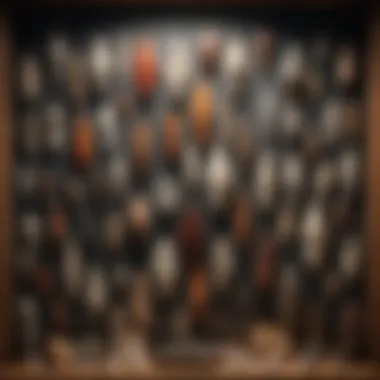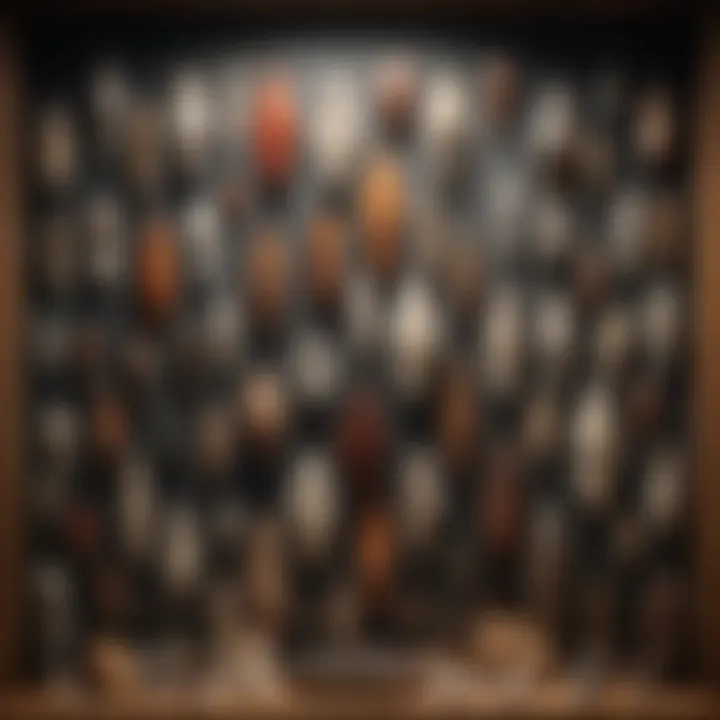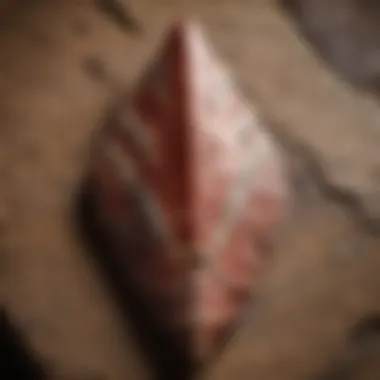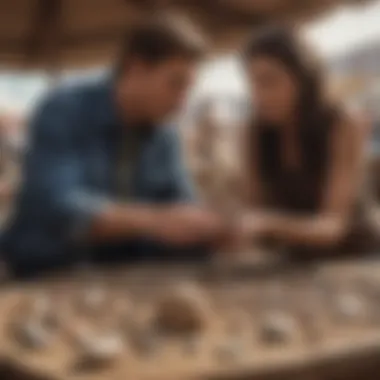Insights into Arrowhead Buyers: Trends and Motivations


Intro
In the intricate world of collecting, few niches are as remarkable as arrowhead collecting. This pursuit, often seen as a blend of history, art, and adventure, attracts different individuals for varying reasons. Whether they are casual hobbyists, dedicated archaeologists, or seasoned collectors, each group brings unique motivations, challenges, and appreciation for these fascinating artifacts. Understanding these players in the market can illuminate trends that might otherwise go unnoticed, shedding light on what shapes their choices and drives their passions.
Featured Collectible of the Month
A monthly highlight can offer valuable insights into current trends among arrowhead buyers. One such remarkable piece worth considering is the Paleoindian Clovis point.
Overview
The Clovis point is a spearhead that dates back to approximately 13,000 years ago. Characterized by its distinct fluted shape, it represents an exceptional convergence of functionality and artistry. Arrowhead enthusiasts are often eager to add a Clovis point to their collections, not only for its aesthetic appeal but also for its historical relevance.
Historical Significance
This specific artifact links to the ancient peoples of North America, giving a glimpse into prehistoric life. Clovis points were instrumental during a period when hunting large game was crucial for survival. Their significance extends beyond mere beauty; they serve as reminders of human ingenuity and adaptability in early civilizations. Collectors find a narrative interwoven with these points — a story of survival, exploration, and resourcefulness.
"For many collectors, each arrowhead tells a story far beyond its physical presence; it embodies the spirit of its time."
Identification Techniques
Understanding arrowhead identification is pivotal for anyone looking to engage deeply with this market. Recognizing these artifacts involves more than just a keen eye; knowledge of their visual characteristics and available resources can greatly enhance a collector's journey.
Visual Characteristics
When examining arrowheads, several features come into play that aid in identification:
- Shape: Arrowheads can vary greatly in shape, from triangular to leaf-like forms.
- Material: Common materials include flint, obsidian, and bone.
- Size: Dimensions can indicate the arrowhead's intended use or the culture it originates from.
- Flaking Patterns: The craftsmanship shown in the flaking technique can provide critical clues about the time period and geographic location.
- Patina: Over time, arrowheads develop a natural patina, which can give insight into their age and authenticity.
Resources for Identification
Several resources can assist budding or seasoned collectors alike in identifying arrowheads more confidently:
- Books on Archaeological Methods: Titles such as Flintknapping: A Guide to Making Your Own Stone Tools cater to both hobbyists and researchers.
- Online Forums and Communities: The Reddit platform has active discussions in communities like r/Arrowheads, where shared experiences can inform identification processes.
- Museums and Archaeological Societies: Many local museums offer educational programs that assist in the proper identification and appreciation of arrowheads.
Prelims to Arrowhead Collecting
The world of arrowhead collecting is a fascinating intersection of history, art, and personal passion. As we step into this realm, it becomes clear that understanding arrowhead collecting is not simply about gathering these artifacts; it’s about connecting with the narratives behind them. Collectors delve into the unique histories that each arrowhead represents, forming a bridge between the past and present. This section aims to unpack the layers of significance in arrowhead collecting, reflecting on both its cultural importance and the insights it imparts to collectors.
Historical Significance of Arrowheads
Arrowheads, as artifacts, carry deep historical weight. Each piece can serve as a tangible link to ancient peoples, their ways of life, and their survival strategies. They are remnants of a time when these tools defined human interaction with nature, often critical for hunting and protection. The material used, the style of craftsmanship, and the sites where they are found can reveal much about the people who made them.
Among the many cultures that utilized arrowheads, we see diverse manufacturing techniques and shapes that signify not just functionality but artistry. For instance, the differences in flintknapping methods between the Clovis culture and the later Native American tribes illustrate the evolution of tool-making practices over thousands of years. This makes each arrowhead not just a collectible but also a narrative of human advancement and adaptation.
Cultural Context and Artifact Value
The value of arrowheads extends beyond mere monetary estimates; it intertwines with cultural identity and heritage. Collectors often find themselves motivated not just by a desire to own these artifacts but to preserve and honor the stories they tell. Understanding the cultural significance of these artifacts is crucial for discerning their worth in today’s market.
Arrowheads can reflect regional styles, showing how geography influences tool design—much like how gourmet foods reflect local ingredients. Collectors and enthusiasts frequently discuss the value of provenance. A well-documented history of a specific piece can dramatically enhance its status among collectors, sometimes turning a simple arrowhead into a sought-after historical document.
"Every arrowhead holds a story waiting to be discovered—consider that next time you hold one in your hand."
In summary, the section on the introduction to arrowhead collecting lays the groundwork for understanding why and how these artifacts capture the interest of various types of collectors, from amateurs to seasoned historians. As we look deeper into the motivations and demographics of arrowhead buyers, it becomes clear that these artifacts are not merely objects; they are the echoes of human history and art.
Identifying Arrowhead Buyers
Understanding who the arrowhead buyers are is crucial in deciphering the intricate landscape of this niche market. The variety of individuals drawn to arrowheads—ranging from casual collectors to professionals in archaeology—presents a mosaic of motivations and preferences. By recognizing the specific demographics and psychographics that dominate this field, sellers can tailor their offerings and strategies more effectively, ultimately creating a more satisfying experience for both parties involved.
Demographics of Arrowhead Buyers
The demographic profile of arrowhead buyers reveals a diverse range of participants. There’s a notable variety in age, gender, and geographic locations among these collectors, each contributing different perspectives and approaches toward arrowhead collecting.


- Age Groups: It's common to find that many buyers fall into the age range of 30 to 65. Younger collectors, often in their twenties and thirties, may be more inclined toward starting their collection for personal enjoyment or educational purposes. In contrast, the older generation tend to view arrowheads through the lens of historical significance, often seeking rare pieces to complement their existing collections.
- Gender: While traditionally, the collecting space has skewed male, the involvement of female collectors is on the rise. This shift points toward a growing appreciation among women for archaeology, cultural artifacts, and historical narratives tied to arrowheads.
- Geographic Distribution: Arrowhead collectors are not confined to a single region; the practice is widespread across the United States, with particular hotspots in areas rich in indigenous history like the Midwest and Southeast. Collectors in these regions often have better access to artifacts due to local histories and archaeological efforts.
The demographics of arrowhead buyers are a reflection of the societal trends showing how personal interests and educational backgrounds influence collecting habits, making this an intriguing field of study.
Psychographic Profiles
When it comes to understanding arrowhead buyers on a deeper level, the psychographic profiles provide insights that demographics alone cannot. This dives into the motivations, values, and lifestyle choices of collectors, which are crucial to forming a complete picture.
- Values and Interests: Passion for history and ancestry often stands as a key motivator. Many collectors view arrowheads not just as objects, but as connections to past civilizations and cultures. This value system influences the kind of pieces they seek—often gravitating toward items with a compelling backstory or unique craftsmanship.
- Collecting Philosophy: Different collectors approach the hobby with varying philosophies. Some may prioritize rarity and investment potential, while others appreciate the artistic and historical aspects. This can influence how sellers present their offerings, whether through storytelling about the pieces or emphasizing their investment value.
- Interaction with Community: The social aspect of arrowhead collecting can play a big role. Many collectors engage with communities on platforms like Facebook and Reddit, sharing tips, experiences, and even arranging trades. The camaraderie among collectors fosters an environment where knowledge is exchanged and greater appreciation for artifacts is nurtured.
"Understanding the psychographics allows sellers to tap into the underlying emotions and motivations of buyers, turning a simple sale into a meaningful and memorable exchange."
In summary, gaining insights into both demographics and psychographics forms a well-rounded understanding of arrowhead buyers. This knowledge not only aids sellers in targeting their marketing strategies effectively but also enriches the overall collecting experience for buyers. With a deeper grasp of who their customers are and what drives them, sellers can contribute to a vibrant collecting ecosystem.
Motivations Behind Buying Arrowheads
Understanding why people are drawn to collecting arrowheads is crucial in appreciating the broader landscape of arrowhead buyers. Their motivations can be as varied as the artifacts themselves. Some might view their collections as a connection to history, while others could see them as pieces of art. Still, some buyers are in it for the potential return on investment. This section explores these different motivations in detail, offering insight into the psychology of arrowhead collectors and the implications these motivations have on the market.
Passion for History
For many collectors, each arrowhead acquired represents a tangible link to the past. The excitement from unearthing or purchasing an arrowhead isn't just about possession; it's about the narrative woven into each piece. A collector may hold a stone that was once part of a hunting expedition by Indigenous peoples centuries ago. The raw connection to history drives home the realization of heritage, culture, and survival.
Collectors often immerse themselves in historical studies, digging deep into the eras when these tools were made. They might favor specific types of arrowheads, such as the Clovis or Folsom points, which offer insights into early human life in North America. This quest for knowledge amplifies their passion, presenting opportunities for personal enrichment and a deeper appreciation of human ingenuity.
"Passion for collecting feels like holding history in your hand, a reminder of how people lived and created."
Artistic Appreciation
Arrowheads are not merely functional tools; they are also symbolic of human craftsmanship and artistry. Many collectors find themselves appreciating the intricate designs and the aesthetic qualities of these artifacts. This artistic lens drives a segment of buyers to focus on arrowheads with unique shapes, colors, or finishes.
Different cultural contexts also influence what buyers consider beautiful. For example, Native American arrowheads made from specific types of stone, like obsidian, can exhibit stunning shine and detail. This consideration extends beyond just appearance; collectors often develop a preference for arrowheads made using traditional methods, valuing both functionality and artistic expression. In essence, buying becomes a union of passion for craftsmanship and a pursuit of beauty in stone.
Investment Potential
The investment aspect of arrowhead collecting cannot be ignored. While the primary allure often revolves around historical and artistic appreciation, some buyers view arrowheads as a financial asset. The rare and authenticated pieces can fetch impressive sums in auctions or private sales, sometimes skyrocketing in value due to demand.
Savvy collectors keep a keen eye on market trends, attending shows and participating in online forums to stay updated. They may turn to resources such as Reddit or even engage with pages on Facebook to gauge where the market might be heading. In this sense, understanding provenance—a record of ownership—becomes critical. Pieces that have a documented history are more likely to appreciate in value over time.
Here’s a brief look at common considerations around investment in arrowheads:
- Rarity: Unique or rare arrowheads often have higher value.
- Condition: The better the condition, the more appealing it is for collectors.
- Provenance: Items with an established history of ownership tend to attract higher bids.
- Market Trends: Pay attention to shifts in preferences among collectors.
In summary, motivations for buying arrowheads are multi-dimensional, blending personal interest with investment savvy. Collectors are not just acquiring objects; they are investing in history, culture, and sometimes even financial future.
Trends in Arrowhead Collecting
Recognizing the trends in arrowhead collecting is pivotal for anyone involved in this niche market. These trends not only shape buyer preferences and behaviors but also influence the overall dynamics of the market. As cultures shift and collectors evolve, understanding these trends helps buyers and sellers alike to navigate through a landscape that’s constantly changing. It provides insights into what is gaining popularity, the factors influencing these shifts, and identifies potential opportunities which can be leveraged for better collecting or selling strategies.
Emerging Preferences Among Buyers
As the hobby of arrowhead collecting grows, so too does the variety of preferences exhibited by collectors. Modern buyers often seek unique characteristics, such as specific materials or cultural heritage, which become defining factors in their purchases.
- Material Choices: Today, many collectors lean towards stone points made from rare materials like obsidian or flint, which are not only functional but also aesthetically stunning.
- Finished vs. Unfinished: Some buyers are attracted to unfinished arrowheads for their raw beauty and historical significance, whereas others prefer fully crafted ones as a showcase of skill.
- Local Finds: There’s a growing trend toward valuing locally sourced artifacts, with many collectors targeting regional arrowheads that tell stories of their geographic origins.
This shift in preferences often reflects wider cultural trends, like sustainability and appreciation for local art. Collectors are no longer just looking for items; they’re seeking pieces that resonate with their own stories and experiences.
Impact of Technology on Collecting Practices
Technology has a profound impact on how arrowhead collectors discover, evaluate, and purchase their items. The digital age presents tools and resources that were unimaginable just a few decades ago.
- Online Communities: Platforms like Reddit and Facebook house vibrant communities where collectors share knowledge, trade items, and showcase their collections.
- E-commerce Growth: Websites dedicated to selling collectibles provide a vast marketplace where buyers can find arrowheads from various regions, ranging from obscure relics to high-quality artifacts.
- Identification Tools: Applications and websites assist with the identification of arrowheads, helping to distinguish between authentic pieces and replicas. These tools often include databases of shapes, materials, and geographic data.


Technology makes the collecting process not just simpler, but also more engaging, connecting enthusiasts across the globe in a shared passion.
Global Market Trends
Arrowhead collecting is not confined to just a single region or country; it has a growing global market that reflects diverse influences and trends. Understanding these can give insight into where the market is headed.
- Cross-Cultural Interest: Interest in arrowheads is rising not just in North America, but also in other parts of the world where indigenous artifacts hold historical significance.
- Investment Viability: Many collectors now view arrowheads as not just collectibles but potential investments. As values fluctuate, savvy collectors are looking at historical trends to gauge future worth.
- Market Accessibility: With enhanced shipping options and online marketplaces, collectors are no longer limited to local markets. The ability to purchase items from different countries broadens the scope for unique acquisitions.
The global perspective on arrowhead collecting not only diversifies the market but enriches the understanding of cultural heritages within various communities.
In the realm of collecting, understanding the trends provides a richer context in which to appreciate the artifacts themselves. It’s not merely about acquisition; it’s about the stories these items tell and the connections they create across time and space.
Through these evolving trends, arrowhead collecting transitions from a passive hobby to an actively engaged and dynamic exploration of culture and history.
Evaluating Authenticity and Provenance
In the realm of arrowhead collecting, distinguishing the genuine from the imitation takes center stage. Authenticity and provenance hold pivotal importance, as they provide credibility and context to each piece in a collector's arsenal. When buyers can ascertain that an arrowhead is not only genuine but also has a documented history, it enhances its value dramatically. This ensures that collectors are not just investing in a stone artifact but in a piece of history, which often translates to stronger emotional and financial returns.
Furthermore, a solid understanding of provenance helps buyers avoid pitfalls. Sellers who are transparent about the origin and history of their items foster trust. For serious collectors, the journey of their arrowheads—from archaeological sites, previous owners, or historical significance—becomes part of the story that deepens their appreciation.
Understanding Provenance in Arrowhead Collecting
Provenance refers to the chronology of the ownership and location of an arrowhead, a sort of resume for the artifact. Knowing where an arrowhead has been can tell a lot about its age, its cultural context, and often even the materials used in its creation. For instance:
- If an arrowhead originates from a region known for particular styles or craftsmanship, that can significantly influence its perceived value.
- A well-documented provenance might reveal that an arrowhead once belonged to a renowned collector or had a significant archaeological study associated with it.
- The ability to trace back the chain of possession can shield collectors from acquiring stolen or illegally sourced artifacts, keeping the spirit of collecting both ethical and respectful.
Articulating the importance of provenance leads to better informed buying decisions among collectors. Therefore, establishing verifiable histories should be a standard practice for any concerned buyer.
Tools for Authenticity Verification
With the digital age at our fingertips, collectors have access to various tools for verifying authenticity. Here are some recommended methods:
- Expert Appraisals: Enlisting a professional for a physical evaluation can provide valuable insights. These experts often have access to databases and extensive experience that can illuminate minute details.
- Material Analysis: Technologies that analyze the composition of materials can demonstrate whether an arrowhead is made of authentic stone used in ancient periods.
- Online Resources: Websites like Wikipedia can offer basic guidelines on identifying arrowhead types or styles, while forums on Reddit can connect collectors seeking advice or information.
- Provenance Documentation: Sellers should ideally provide original documents proving the history of the artifact. Looking for quality certification from a recognized authority can also assure buyers.
- Photographic Records: Cross-referencing images with known genuine examples can often yield immediate insights about an arrowhead's authenticity.
By utilizing these tools, collectors can navigate the tricky waters of authenticity with more confidence, enriching their collection with valuable and verified artifacts.
Sales Channels for Arrowhead Buyers
When diving into the realm of arrowhead collecting, the sales channels available to buyers play a significant role in shaping their experience. Whether a collector’s in it for passion or investment, choosing the right platform can make all the difference. Each sales channel offers unique advantages and challenges that can influence the quality of what is acquired and the overall satisfaction of buyers.
Online Marketplaces
In today’s digital age, online marketplaces have revolutionized how collectors buy arrowheads. Websites like eBay or Etsy allow buyers to access a broader spectrum of inventory without the constraints of geographical limitations.
- Vast Selection: The variety found within online marketplaces is staggering, featuring everything from common pieces to rare artifacts. This vast selection caters to different preferences and budgets, enabling buyers to find what resonates with their collecting goals.
- Ease of Searching: Most platforms come equipped with advanced search features. This makes locating specific items, like projectile points from a particular region, incredibly efficient. Easy filtering options help narrow down to desired categories and pricing ranges.
- Buyer Feedback and Seller Ratings: A safety net is provided through buyer feedback systems. Reviews and seller ratings can offer insights into a seller’s reliability, which is invaluable when purchasing more expensive items.
However, it’s essential to exercise caution online. Counterfeits are prevalent, and not every seller guarantees authenticity. Therefore, keen eyes and a thorough understanding of how to authenticate arrowheads become vital.
Auctions and Shows
Auctions and shows present a different flavor to the buying experience, combining excitement with a sense of community. These events—whether local, national, or even online—offer collectors the chance to engage face-to-face or bid on unique items in real-time.
- In-Person Interaction: At live shows, collectors get an opportunity to handle arrowheads, inspect them closely, and engage with sellers about their historical value. Such interactions often illuminate stories behind the pieces, connecting collectors to their artifacts in a more profound way.
- Competitive Bidding: Auction platforms, both physical and virtual, can spark competitive bidding. This situation often leads to buyers securing items at surprisingly lower prices compared to set listings. This thrill is unique and can heighten the collector's sense of accomplishment.
- Specialized Shows: Events focusing solely on archaeology or collectibles often showcase rare finds and expertise. These specialty shows provide an invaluable opportunity to meet experienced collectors and experts, allowing for knowledge exchange and networking which can benefit long-term collecting strategies.
While auctions and shows can offer excitement and exclusivity, they also require a level of preparedness. Taking note of auction house fees and doing prior research on pieces becomes critical for making informed decisions.
"The journey of collecting goes beyond just obtaining items; it’s about understanding their journey and significance in history."
Challenges Faced by Arrowhead Buyers
The journey of an arrowhead buyer can be as multifaceted and intricate as the arrowheads themselves. Within this realm, buyers encounter a host of challenges that can influence their collecting experience. Addressing these concerns is vital for individuals keen on building their collection while navigating the complexities of the market.


Dealing with Counterfeits
When it comes to collecting arrowheads, one of the nagging issues that buyers face is the prevalence of counterfeits. The allure of unique artifacts often attracts unscrupulous sellers, making the pursuit of authentic items feel like searching for a needle in a haystack.
Identifying a genuine arrowhead from a cleverly crafted fake can be tricky. Many buyers rely on expert opinions or advanced research to distinguish the real from the replicas. For instance, paying attention to subtle details such as the material, flaking patterns, and wear marks can provide insights into the authenticity of an arrowhead.
Moreover, seasoned collectors often suggest asking about the provenance of the items before making a purchase. Having a traceable history can significantly bolster the credibility of a piece. Buyers should also become acquainted with industry-standard resources and guides to educate themselves further. This way, they won’t feel like they're buying a cat in a bag!
"Understanding the elements of authenticity arms you with the knowledge needed to avoid pitfalls and ensure the integrity of your collection."
Market Saturation and Price Fluctuations
Another challenge that arrowhead buyers grapple with is market saturation, leading to unpredictable price fluctuations. As more people are drawn into the world of arrowhead collecting, supply begins to meet demand—and sometimes exceed it. This can lead to a variety of consequences for buyers, from inflated prices for ordinary pieces to the difficulty of finding specific, rare items.
Prices can be influenced by factors such as the rarity of a type of arrowhead, its historical significance, or even current trends in collecting. For example:
- Common Types: These might see a drop in price due to oversupply.
- Rare Finds: Conversely, they can spur bidding wars at auctions, substantially elevating their market value.
Buyers must invest time into market research, staying updated on trends via forums and groups on platforms like Reddit and Facebook. Additionally, keeping a close eye on auction results and the offerings of major online marketplaces often helps buyers gauge what's reasonable and what's edging into the realm of exaggerated pricing.
The Future of Arrowhead Collecting
The future of arrowhead collecting holds a unique blend of excitement and uncertainty. As new buyers enter the arena and seasoned collectors adapt to a changing market, several trends are emerging that could redefine how this niche is perceived and practiced. This evolving landscape brings forth different considerations that not only impact buying patterns but also influence cultural appreciation of these artifacts.
The continued interest in arrowhead collecting is underpinned by several crucial factors. One is the accessibility of information. With technology evolving, potential collectors can easily access databases, join discussion forums, and connect with other enthusiasts. This enables them to make informed decisions and fosters a community that shares knowledge and experiences.
Also, shifting buyer demographics mean that newer, younger collectors are eager to jump into the field. Often drawn by both aesthetic appeal and historical significance, they approach collecting with a fresh perspective that may lead them to value different aspects than a previous generation. The blending of historical appreciation with modern trends could very well redefine the narrative around arrowhead collecting.
"The beauty of arrowheads lies not solely in their age or craftsmanship but also in the stories they hold and the community they inspire."
Predictions for Buyer Trends
Looking ahead, we can anticipate some noteworthy trends shaping the preferences of arrowhead collectors. Firstly, there seems to be a growing inclination towards sustainability and ethical sourcing. As more buyers prioritize environmental considerations, the appeal of collecting responsibly sourced arrowheads may rise. Buyers could show increased interest in materials that are ethically excavated or artifacts with clear provenance, which influences both market value and collector satisfaction.
Another pertinent trend is the blending of technology with collecting practices. Virtual reality experiences and augmented reality applications may emerge, allowing buyers to experience arrowheads in immersive environments. This could provide insights into their historical contexts and cultural significance, enhancing the overall collecting experience.
Additionally, the rise of social media platforms as avenues for buying and selling arrowheads will likely grow. Collectors are now engaging in discussions, showcasing their collections, and even conducting transactions through platforms like Facebook and Reddit. Expect this trend to flourish, allowing for a more dynamic and interactive community.
Potential for New Collectors
The prospective growth of the arrowhead collecting community lies significantly in attracting new collectors. Demographics are shifting, and younger audiences show heightened interest in historical artifacts linked to personal narratives and broader cultural contexts. The potential here is immense, as this age group brings with it fresh enthusiasm and a yearning for authenticity.
New collectors often seek experiences rather than mere acquisitions. Offering educational workshops, guided digs, and community events can encourage these individuals to engage deeper with the hobby. This approach not only cultivates a sense of belonging but also transforms the act of collecting into a shared journey.
Moreover, the accessibility of information makes it simpler for beginners to start their collections. With countless online resources and community support, anyone can become a collector, irrespective of their previous knowledge. It is essential for seasoned collectors to welcome and mentor these newcomers, as they will help propagate the appreciation for arrowheads as cultural artifacts.
Finale: The Evolving Landscape of Arrowhead Collecting
As we wrap up this exploration into the multifaceted world of arrowhead collecting, it's vital to reflect on how the landscape has transformed yet continues to evolve. This evolution stems from shifting buyer demographics and inventive technology, which collectively reshape what it means to be an arrowhead collector today. The significance of understanding these changes cannot be understated, as it affects both buyers and sellers navigating this niche market.
Reflecting on Buyer Relations
When examining buyer relations, it’s essential to highlight a few noteworthy trends. In the traditional sense, arrowhead collectors have often been seen as solitary enthusiasts, rummaging through fields or visiting markets on the hunt for their next prized piece. However, today’s collectors are increasingly forming communities, engaging through social media platforms like reddit.com or specific Facebook groups that cater to this passion. This new connectivity fosters knowledge exchange about authenticity, best practices, and buying opportunities—or even trade a few pieces just for fun.
Moreover, the rise of online marketplaces has shifted the dynamics of buyer relations. With platforms such as eBay and Etsy coming to the forefront, there's an abundance of choice available at the collectors’ fingertips. This aspect cultivates a sense of camaraderie as collectors share tips on how to identify legitimate listings versus counterfeits. The relationships nurtured through dialogue and shared experiences help reinforce a supportive community around this hobby.
Encouraging Engagement with Collectibles
To ensure the future of arrowhead collecting remains vibrant, it is crucial to encourage engagement among both seasoned collectors and newcomers. Educational efforts are necessary, such as workshops, seminars, or online webinars that can enhance understanding and appreciation of the craft. Initiatives that promote local excavations or artifact showcases can also pique interest, allowing potential buyers to experience the history tied to these artifacts firsthand.
Furthermore, creating platforms where collectors can display their finds and share personal stories regarding their artifacts can ignite passion in new buyers. This storytelling element reinforces the notion that every arrowhead possesses a narrative, contributing to its value as a collectible. An emotional connection often leads to deeper engagement; thus, when buyers hear tales of the past, the appeal of adding to their own collection may become irresistible.
The continuous evolution of the arrowhead collecting scene highlights the delicate weave between history, personal connection, and market trends. As buyers increasingly connect with their artifacts and each other, they contribute to a living tapestry that enhances the appreciation of these historical relics.
"The past is a treasure chest, and each arrowhead is a key to unlock its secrets."
As this landscape advances, both sellers and buyers are encouraged to embrace change, continually investigating new pathways for connection and engagement in this enduringly rich hobby.



